There are a variety of different spiders in Kentucky, and this article will cover 49 species that live in the state.
Spiders are one of the earth’s most feared animals, but most species are harmless. While nearly all spiders possess some sort of venom, there are only a select few with venom strong enough to be medically significant to humans.
In Kentucky, there are a few spiders that you should know about that have potent venom, but the majority of them are harmless. Spiders are actually more beneficial than dangerous since they help control the population of pest insects, and are a valuable food source for some animals.
You may not think twice about the spiders you see on a regular basis, but taking a closer look at them can show you how unique each species can be. If you know where and when to look you can easily find the various spiders in Kentucky, and the various lifestyles they live.
Spiders are common everywhere from deep in the wilderness to the inside of homes. Identifying a species is possible by examining a spider’s physical traits, behavior, when and where it was found, and also its silk.
Here are 49 spiders that you can find in Kentucky, and everything you need to know about them.
Table of Contents
Spiders in Kentucky
1. Starbellied Orbweaver

- Experience Level: Intermediate
- Family: Araneidae
- Scientific Name: Acanthepeira stellata
- Other Names: n/a
- Adult Size: 5 to 15 mm ( 0.19 to 0.59 inches)
- Lifespan: 1 year
- Average Price Range: $20
The abdomen of the star-bellied orb weaver is what gives this spider its name, and makes them easily identifiable from other species.
This spider has 12 star-like points that protrude from its abdomen, coming out from all directions. Males of this species also have this trait, but their bodies are not as large as females.
Star-bellied orb weavers have a coloring that ranges from dark to light brown. Their legs have bands on them, and small hairs cover their body.
Late spring and early fall are when this spider is seen the most. They live in Kentucky, but this spider’s range stretches across North America from Canada to Mexico.
Meadow and grassland habitats are where this spider lives. This species is nocturnal and is usually seen doing its web-building and eating when the day has gone.
The web of this spider is capable of being made up to 1 foot in diameter and is used to catch insects like flies, moths, and beetles. As an orb weaver species, this spider’s webs are shaped like a wheel, and only females create them.
Star-bellied orb weavers wait in the corner of their web for food to fall into their silk. They use vibrations, and ambush the unsuspecting meals, killing them with venom.
2. Cat-faced Spider

- Experience Level: Intermediate
- Family: Araneidae
- Scientific Name: Araneus gemmoides
- Other Names: Jewel Spider
- Adult Size: 5 to 7 mm (0.19 to 0.27 inches)
- Lifespan: 1 to 2 years
- Average Price Range: n/a
Cat-faced spiders are a small species of orbweaver that can be found in Kentucky. Cat-faced spiders have tan to reddish brown coloring, with dark bands running down their legs.
This spider gets its name from its body and abdomen, which some say look similar to a cat. The abdomen of this spider has two holes that look like a cat’s eyes, and pointed humps that look like a cat’s ears. Males look similar to females but have a sleeker and more pointed bodies with long legs.
Females of this species build orb-shaped webs to live in, while males spend their time wandering looking for a mate. This species is active from spring to fall, and mating occurs in the late summer or fall.
Females lay an egg sac but die a bite after, while the eggs overwinter to hatch in the next spring. When the babies hatch they spread out and even travel by ballooning.
This spider builds its webs in well-lit areas with places for them to hide. On porches, trees, and overhangs are where this spider makes its web.
They feed on insects like flies that get caught in their silk. This spider is harmless to humans, but its venom helps kill its prey.
3. Orchard Orbweaver
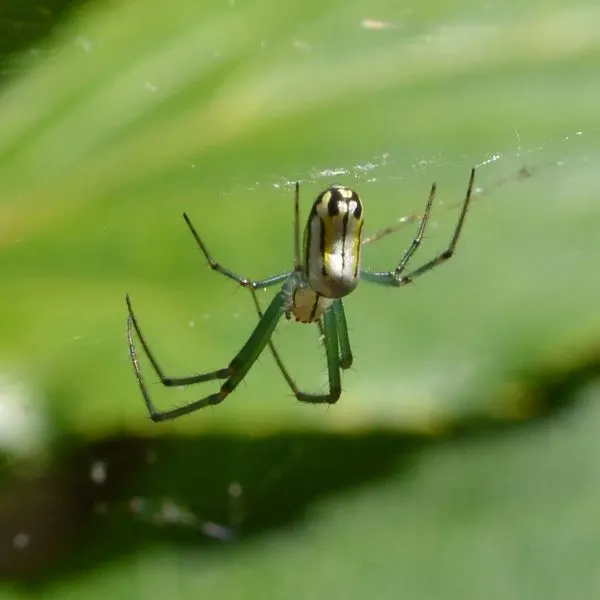
- Experience Level: Intermediate
- Family: Tetragnathidae
- Scientific Name: Leucauge venusta
- Other Names: Orchard spider
- Adult Size: 3.5 to 7.5 mm (0.13 to 0.29 inches)
- Lifespan: 1 year
- Average Price Range: $20
Orchard orb-weavers can be found all across Kentucky, and mainly inhabit the eastern United States. This spider is a colorful species, with a dark emerald green coloring.
On their abdomen are silver, orange, and yellow markings, and there’s an orangish crescent on their belly. Females of this species have elongated abdomens, with spindly legs.
Male orchard orbweavers are not seen as often, but maybe sometimes seen sitting in a female’s web. Males have small abdomens, but their legs are longer.
Spring is when this spider begins to become active, but they mate and lay their eggs at the end of summer. Eggs are laid on sticks, and leaves and spiderlings will start emerging when the weather begins to warm.
Orchard orbweavers are found in both North and South America. This species lives in areas with lots of vegetation like parks, meadows, grasslands, and gardens.
Orchard orbweavers are useful spiders to have around since they kill pest insects that feed on plants. Gardens and agriculture fields benefit from this spider, and this species is harmless to humans.
Wasps are the main predator that the orchard orbweaver faces but this spider also feeds on wasps. Birds, other spiders, and lizards are also common predators this spider faces in the wild.
4. Arabesque Orbweaver
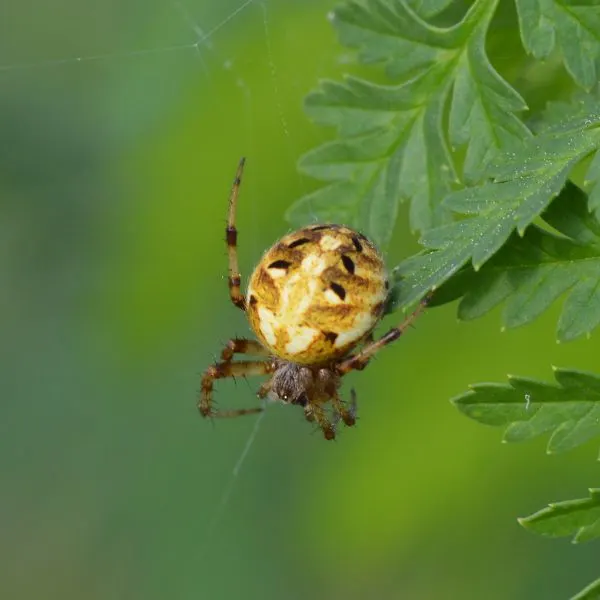
- Experience Level: Intermediate
- Family: Araneidae
- Scientific Name: Neoscona arabesca
- Other Names: n/a
- Adult Size: 5 to 7 mm (0.19 to 0.27 inches)
- Lifespan: 1 year
- Average Price Range: n/a
The arabesque orbweaver can be distinguished from other orbweavers by the swirling arabesque pattern that appears on their abdomen.
This spider appears in brown, black, orange, yellow, or white colorings. The swirling pattern that gives this spider its name is lighter than its base color, and hair covers this spider’s entire body.
Female arabesque orbweavers have large round abdomens, while males have smaller and more pointed bodies. Males have larger legs and big heads.
The night is when this spider is active, and females build a circular web to sit in. Males wander looking for a mate, sometimes found in vegetation or near a female’s web.
Arabesque orb weavers live across North America, in habitats like gardens, meadows, grasslands, and forests. At night females are sometimes seen sitting in the center of their web, waiting for food to get caught in their silk.
This spider feeds on small insects like gnats, flies, and moths. This spider is most active in the summer and fall months.
They are harmless to humans and will flee unless provoked. Arabesque orbweaver like this species have poor eyesight.
To know when things are around or in their web this spider relies on vibrations, and senses things with the thick hairs on its legs.
5. Furrow Orbweaver

- Experience Level: Beginner
- Family: Araneidae
- Scientific Name: Larinioides cornutus
- Other Names: Furrow orb weaver
- Adult Size: 10 to 12 mm (0.39 to 0.47 inches
- Lifespan: 1 year
- Average Price Range: n/a
The furrow orbweaver is identifiable by the furrow-shaped marking that runs down the center of its abdomen. This spider has a brown abdomen and is covered in many small hairs.
Dark bands cover their tan legs, and their carapace has a dark brown coloring. Males are smaller than females, and the furrow pattern that appears on their abdomen is less bold on them.
Furrow orb weavers are a common species in Kentucky and other parts of North America. This spider has a larger range across the globe and is also found in parts of Africa, Europe, and Asia.
This spider is often found near bodies of water and is most active in the warm months of summer and fall. Females furrow orbweavers build circle webs to live in, which are useful in catching their next meal.
This spider feeds on flying insects like gnats, mosquitos, and moths. When something gets caught in its web this spider will wrap their prey up in silk, and inject them with venom.
This spider is harmless to humans, and bites from them are similar to that of a bee sting. This species is active at night, and you are most likely to see them in Kentucky on a warm summer night.
6. Hentz Orbweaver
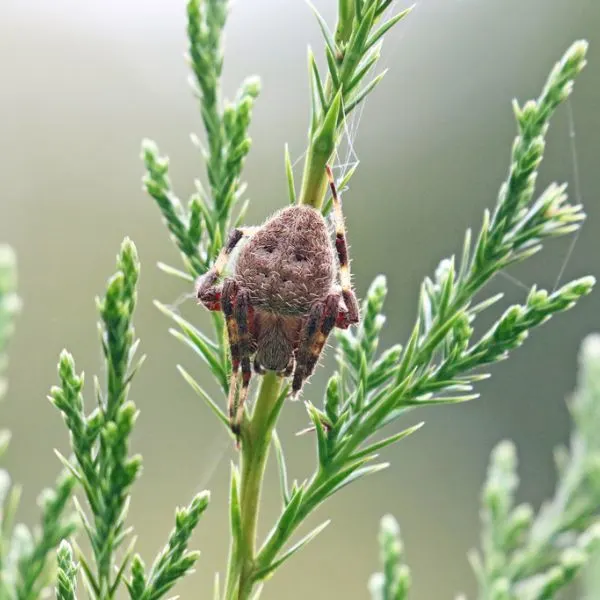
- Experience Level: Intermediate
- Family: Araneidae
- Scientific Name: Neoscona crucifera
- Other Names: Spotted orb weaver
- Adult Size: 5 to 20 mm (0.19 to 0.78 inches)
- Lifespan: 1 year
- Average Price Range: n/a
The Hentz orbweaver is a spider found all across the United States and is a species you may find in Kentucky.
The Hentz orbweaver has tan coloring and is covered in many tiny hairs. These hairs help them sense the world with vibrations, and are thicker on their legs.
Hentz orbweavers have tan to gray coloring, and dark bands on their legs. This spider is also called the spotted orbweaver since they have two white posts on the underside of its abdomen.
This spider is active at night, and this is also when they build its circular web. Hentz orbweavers live in habitats such as woodlands, grasslands, parks, and backyards, as they prefer moist habitats.
This spider will sometimes build its webs on the sides of houses, usually near lighting where an abundance of insects is present. When not active during the day this species will hide in a secluded area near its web.
Hentz orbweavers feed on insects that fly into their web at night. Insects like moths, mosquitos, and gnats are some of the things they eat.
Wasps are this spider’s main predator, and they will paralyze them, and use them as food for their larvae. Like other orb weavers, Hentz orbweavers are harmless.
7. Giant Lichen Orbweaver
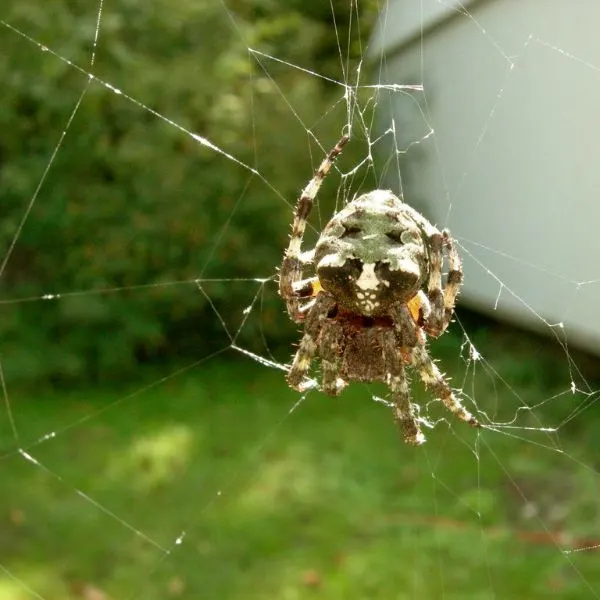
- Experience Level: Intermediate
- Family: Araneidae
- Scientific Name: Araneus bicentenarius
- Other Names: n/a
- Adult Size: 10 to 30 mm ( 0.39 to 1.18 inches)
- Lifespan: 1 year
- Average Price Range: n/a
Giant lichen orbweavers are one of the largest species of orb weaver in Kentucky. This spider has light green coloring, with a brown mottled pattern on them.
They have a dark marking similar to the furrow orbweaver running down them. Females of this species have humps protruding from their abdomen.
Males have smaller abdomens but longer legs. In the wild, this spider is easily confused for the lichen you can find on trees or rocks due to its coloring and pattern.
Giant lichen orb weavers live in Kentucky and are common in other eastern and mid-western United States. This spider lives in moist woodland habitats, and females create large webs to live in. The trees and shrubs of the area are used by this spider to make her web, which can be up to 6 feet large.
When in their web this spider waits at the edge of it for insect prey to fall in her silk. Wrapping up and injecting their prey with venom helps keep the spider safe when feeding if the meal has any stingers.
Predators of the giant lichen orbweaver like birds also mistake them for lichen. This species is active at night, and their lichen-like appearance helps them camouflage in the day when resting.
8. Marbled Orbweaver
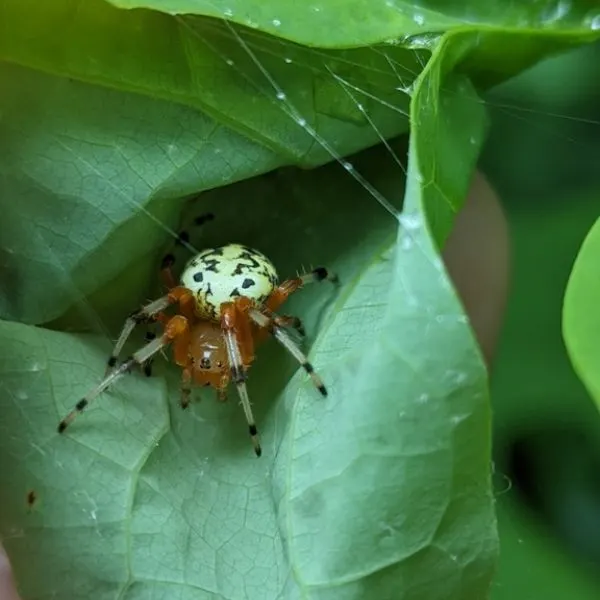
- Experience Level: Intermediate
- Family: Araneidae
- Scientific Name: Araneus marmoreus
- Other Names: Pumpkin spider
- Adult Size: 9 to 22 mm (0.35 to 0.86 inches)
- Lifespan: 1 year
- Average Price Range: $20
Marbled orbweavers have a marbled pattern that appears on their abdomen.
This species is found in orange, yellow, and white coloring. Dark bands run down their legs, and they have a dark stripe that runs down the center of their cephalothorax.
The marbled pattern on this spider can either be dark or light-colored. This species is also called the pumpkin spider because of its round orange look.
In vegetated areas like meadows, wetlands, and moist woodlands are where this species is common. Areas with lots of things like grass, weeds, and medium-sized plants are where they will build their web.
In their web, there is a retreat for them to escape to rest. This species is nocturnal and is most active in the warm months of summer and fall.
The marbled orb weaver mates in the fall, and the spiderlings begin to hatch next year in the spring. The marbled orb weaver begins to mature in the fall.
Their egg sacs are yellow, and they watch them from a retreat in their web. Flying insects that get caught in their web is this spider’s main source of food. They are harmless and do not bite unless provoked.
9. Shamrock Spider

- Experience Level: Intermediate
- Family: Araneidae
- Scientific Name: Araneus trifolium
- Other Names: Shamrock orbweaver
- Adult Size: 19 mm (0.74 inches)
- Lifespan: 1 year
- Average Price Range: n/a
The Shamrock spider varies in the colors that it appears in. White, red, orange, yellow, and purple are some of this species’ possible colors. This spider has a large bulbous abdomen, with long spindly legs.
Dark bands appear on the spider’s legs, which are usually a light tan, or brown. The several white spots that appear on this spider’s back are what help distinguish this spider from other similar species.
Shamrock spiders are found across North America and are a common species in Kentucky. This spider lives in woodlands, and grassland habitats near freshwater sources.
Orbweavers require moisture near their habitat since they drink the water droplets that fall on their web. Spring to fall is when this spider is active, but they are seen most in the months of summer and fall. In winter adults of this species die off, while the eggs and spiderlings overwinter until spring.
This spider is one of many that is beneficial to find in gardens, and other areas since they prey on pest insects, and other bugs. This spider uses its web to catch prey and hides nearby until something falls into its trap.
It uses a string and vibrations to sense where insects fall in its web. They ambush and inject their prey with paralyzing venom.
10. Red-spotted Orbweaver

- Experience Level: Intermediate
- Family: Araneidae
- Scientific Name: Araneus cingulatus
- Other Names: n/a
- Adult Size: 2 to 6 mm (0.1 to 0.24 inches)
- Lifespan: 1 year
- Average Price Range: n/a
The red-spotted orbweaver gets its name from the red spots that appear on its rounded abdomen.
This spider has translucent green coloring, with yellow, white, and reddish markings that appear on its abdomen along with its spots. The green coloring contributes to the secretive lifestyle of this spider, as it helps them blend into the various vegetation that they live on.
The red-spotted orbweaver is seen most in the fall months. Habitats like grasslands, meadows, and urban areas are regular places to find the red-spotted orbweaver.
This small species can be spotted on vines and other plants. The red-spotted orbweaver uses its green coloring to camouflage and avoid predators like birds, lizards, and small mammals.
Other spiders and insects like aphids are what this species feeds on. This species is harmless to humans and is likely to not even be noticed.
11. Difoliate Orbweaver

- Experience Level: Intermediate
- Family: Araneidae
- Scientific Name: Acacesia hamata
- Other Names: n/a
- Adult Size: 4.7 to 9.1 mm (0.18 to 0.35 inches)
- Lifespan: 1 year
- Average Price Range: n/a
The Difoliate orbweaver is recognizable by the pattern that appears on its abdomen, which is a V-shaped marking with a dagger-like mark in the middle. This species has tan too orange coloring.
Their abdomen is round, while their legs are thin and nimble. This spider is a medium-sized species, with a few thin hairs covering its legs.
In grasslands, fields, and other areas with lots of low-lying vegetation. This spider sits on the leaves of plants like bushes, and tall grass.
The summer and fall months are when you’re most likely to see this species. When sitting on a plant difoliate orbweavers sit in a position with their legs together and pointed down.
12. Arrow-shaped Micrathena
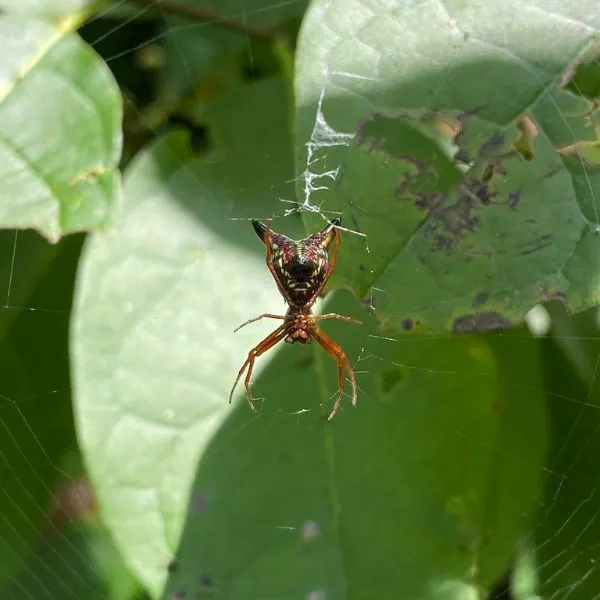
- Experience Level: Intermediate
- Family: Araneidae
- Scientific Name: Micrathena sagittata
- Other Names: n/a
- Adult Size: 5 to 9 mm (0.20 to 0.35 inches)
- Lifespan: 1 year
- Average Price Range: n/a
The arrow-shaped orb weaver gets its name from its odd-shaped abdomen. The end of this species’ abdomen looks similar to that of the two points of an arrow.
Two large black spikes protrude from their body, as well as several smaller ones come out of their sides. The abdomen of this spider is yellow, with red shading near its edge, and black dimples on them. Their carapace and legs have a red to reddish-brown coloring.
Arrow-shaped orb weavers live in woodlands and urban habitats. They build circular webs similar to other orbweavers, held up by the surrounding plant life.
Summer and fall are when this spider is active, and they are active during the day. Females spend their time alive feeding on insects and then laying eggs, while males wander and look for a female’s web.
Flying insects like mosquitoes, and leafhoppers are what this spider feeds on. They use their sticky silk to catch the flying insects where they live, and their venom to neutralize their prey.
This spider is harmless to humans and is beneficial in controlling insect populations. Predators like birds and wasps are this spider’s main threat.
13. Spined Micrathena
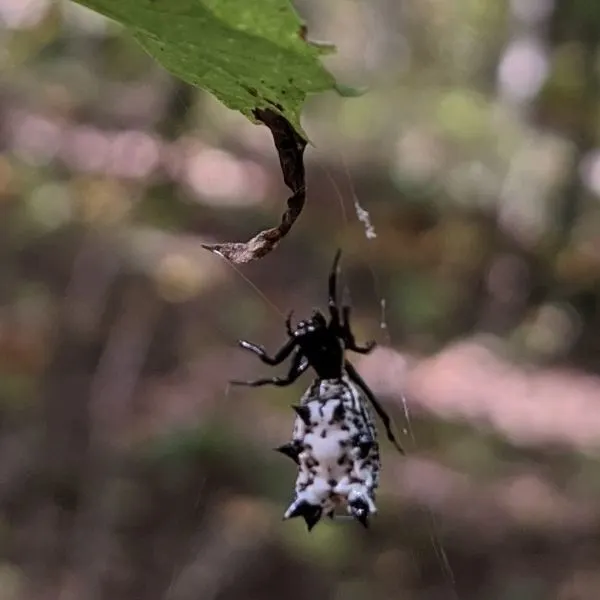
- Experience Level: Intermediate
- Family: Araneidae
- Scientific Name: Micrathena gracilis
- Other Names: Castleback orbweaver
- Adult Size: 4 to 10 mm (0.15 to 0.31 inches)
- Lifespan: 1 year
- Average Price Range: n/a
Spined micrathena have black spikes that protrude from their abdomen which give this spider its name. This spider’s abdomen is round and points upward.
They have black dimples, and a mottled pattern with a possibility of red, yellow, black, and orange coloring. Males of this species are much smaller in size and lack any spikes on them. They have brown coloring and a small elongated abdomen.
Native to North America, the spined micrathena builds large webs to live in that are orb-shaped. Only females build orb-shaped webs in the orbweaver family.
Males primarily use their silk to mate or travel. Forest and woodland habitats are where this species lives. Near their home, there is usually a body of water like a lake, pond, or wetland.
Summer is when the spined micrathena is active most and spends this period mating. Females lay eggs that are dormant in the winter, and hatch in the next spring.
Spined micrathena are active during the day, and during this period they spend their time rebuilding their web. Insects are their main source of food, and they The spikes on their body to ward off predators, by hurting their mouths when this spider is attempting to be eaten.
Spined micrathena are harmless to humans and is one of the many orb weaver species that live in Kentucky.
14. White Micrathena
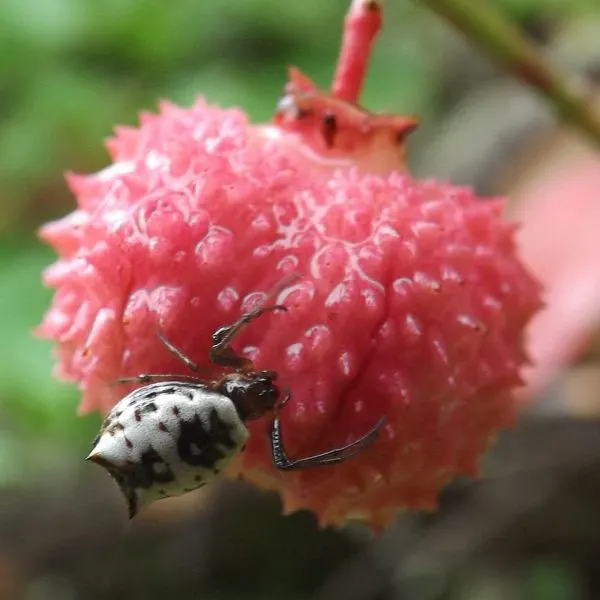
- Experience Level: Intermediate
- Family: Araneidae
- Scientific Name: Micrathena mitrata
- Other Names: n/a
- Adult Size: 4.2 to 10.8 mm (0.16 to 0.42 inches)
- Lifespan: 1 year
- Average Price Range: n/a
The white micrathena has white coloring and a turban-shaped abdomen. This species has a brown mottled pattern that covers its body.
Their cephalothorax and legs have reddish-brown coloring. This spider has small spikes that come out of the end of its abdomen. This spider has a similar appearance to the spined micrathena, but is much smaller, and lacks the large spikes of that spider.
White micrathena live in forest and woodland habitats. They are a very adaptable species, as they are also found in urban areas, in places like parks, gardens, and backyards.
Females of this species create large circular webs to live in. Summer and fall are when you will find this most in Kentucky.
The flying insects that get caught in this species’ web are what this spider feeds on. Mosquitoes, gnats, and small flies are examples of the insects they eat.
White micrathena inject their prey with venom to kill them, but their bite is harmless to humans. Birds are this spider’s main predator, as they will steal the spider’s silk, the bugs caught in the spider’s web, and prey on spiders themselves.
15. Black and Yellow Garden Spider

- Experience Level: Intermediate
- Family: Araneidae
- Scientific Name: Argiope aurantia
- Other Names: Yellow garden spider
- Adult Size: 5 to 28 mm ( 0.2 to 1.1 inches)
- Lifespan: 1 year
- Average Price Range: $8
Black and yellow garden spiders are one of the largest species of orbweaver in Kentucky. Females of this species grow up to an inch and have black and yellow egg-shaped abdomens.
Males are much smaller than females, and can sometimes be seen sitting in the corner of their mate’s web. Black and yellow garden spiders sit in their webs in the shape of a cross.
Meadows, gardens, grasslands, and open woodlands are habitats where this species can be found. They rely on ample vegetation to have areas to build their web.
Down the center of this spider’s web is a zig-zag pattern, called a stablementum. This is why some call spiders that do this zipper spiders. Black and yellow garden spiders are active during the day, which is when they can be seen sitting in the center of their web.
Black and yellow orbweavers feed on insects that get caught in their web. Only females create this web, while males focus on mating.
Since males are so small they are sometimes consumed after mating, he does not get away quickly enough. The male creates a line so he can escape in case he is in danger.
16. Banded Garden Spider
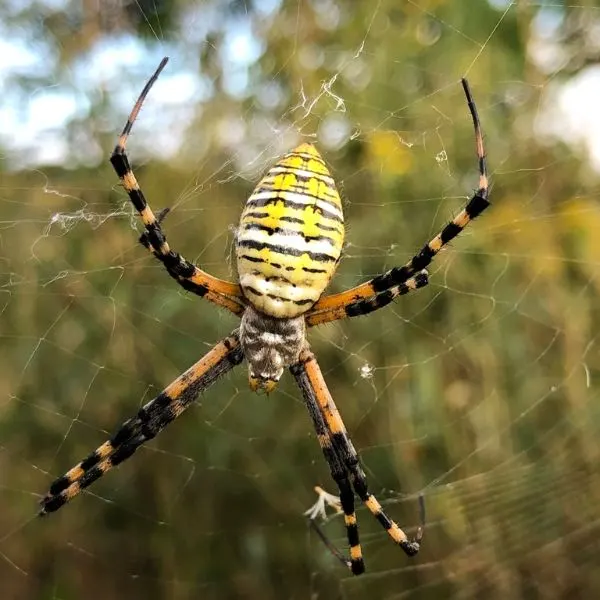
- Experience Level: Intermediate
- Family: Araneidae
- Scientific Name: Argiope trifasciata
- Other Names: Banded orb-weaving spider
- Adult Size: 15 to 25 mm (0.59 to 0.98 inches)
- Lifespan: 1 year
- Average Price Range: n/a
Banded garden spiders are an orbweaver species named after the band pattern that covers their abdomen and legs. This spider has black, yellow, and silver coloring, with an oval-shaped abdomen.
Males of this species are much smaller than females and are only seen when mating. When sitting in its web the spider sits with its head facing down, and legs in an X shape.
Meadows, grasslands, fields, and urban areas are places where this spider lives in Kentucky. The summer and fall months are when this spider is active. This spider builds large circular webs and is active during the day.
Banded garden spiders are seen as beneficial spiders to have around gardens and fields. This spider’s large webs catch insects like butterflies, bees, and wasps for them to feed on.
While this spider has vibrant colors it is harmless, with very weak venom similar to that of a bee.
17. Emerald Jumping Spider
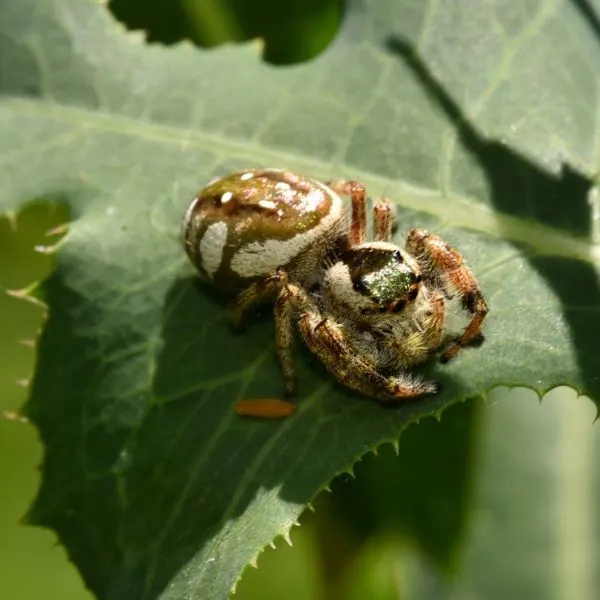
- Experience Level: Beginner
- Family: Salticidae
- Scientific Name: Paraphidippus aurantius
- Other Names: Golden Jumping Spider
- Adult Size: 3.04 mm (0.12 inches)
- Lifespan: 1 year
- Average Price Range: $20 to $30
The emerald jumping spider is named after the streak of emeralds that runs down this spider’s back. They also have white, brown, and black markings on them, and they are covered in hair.
They have small bodies, with angular legs designed for jumping. Emerald jumping spiders can be identified by their vibrant green and another coloring.
This species lives in grasslands and forest areas. They are also found in urban areas, and it is not uncommon for this species to make its way into your home through the smallest of cracks. This spider is active during the day, and at night they create a silk retreat to hide in, usually made in places like a folded leaf.
Emerald jumping spiders spend their day hunting small insects they find, using their excellent eyesight to track their prey. This species will circle prey it sees, and wait for the right moment to jump on it.
Their bites inject deadly venom into the insects they feed on, but this spider is harmless to humans.
18. Dimorphic Jumping Spider

- Experience Level: Beginner
- Family: Salticidae
- Scientific Name: Maevia inclemens
- Other Names: n/a
- Adult Size: 4.75 to 8 mm (0.187 to 0.31 inches)
- Lifespan: 1 year
- Average Price Range: $20 to $30
The dimorphic jumping spider has two morphs for the males of this species. Males can either be black, with cream legs or have gray coloring with a mottled pattern on them.
Females have tan or grayish coloring and look similar to the gray male morph. While they look like two different species, the two morphs of the male are actually the same spider.
This spider lives in grasslands, and open woodland habitats in Kentucky, and other regions within the eastern United States. Dimorphic jumpers are active during the day, and at night they rest in a silk cocoon. This spider spends its time on plants like poison ivy, or wintercreeper looking for meals to eat.
Small insects are eaten by this species, such as bees, and flies. Larger spiders, wasps, and birds are what this spider is eaten by in the wild.
Dimorphic jumpers are great hunters, but they can easily be killed by spiders such as the wolf spider.
19. Ribbon Jumping Spider
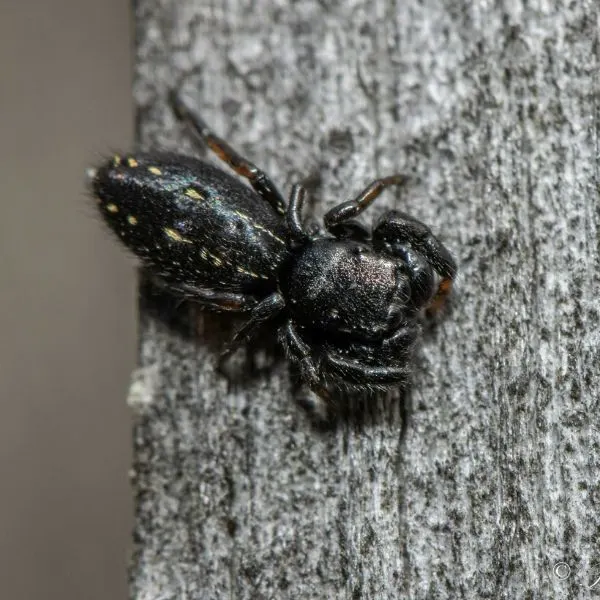
- Experience Level: Beginner
- Family: Salticidae
- Scientific Name: Metacyrba taeniola
- Other Names: n/a
- Adult Size: 4.4 to 7.2 mm (0.17 to 0.28 inches)
- Lifespan: 1 year
- Average Price Range: n/a
Ribbon jumping spiders are small Salticidae that inhabits Kentucky, and are native to North America. This spider has a square-shaped cephalothorax that has black coloring.
They have an elongated abdomen, with two yellowish lines that round down their body. Ribbon jumpers have angular brown legs that let them jump up to 6 inches far. Ribbon jumping spiders are covered in many small hairs and have a shiny appearance.
This species is active during the day and is found in places such as urban areas, woodlands, and fields. They rest under rocks, in bark, and in plant life at night.
The ribbon-jumping spider spends its day wandering, and will rest in a silk sac at night. Mature females focus on hunting, while males look for a mate. Early summer and fall are when this species mates and the young and spiderlings overwinter on plants and in leaf litter when the cold comes.
The ribbon jumping spiders feed on small insects and hunt by pouncing on their prey. They stalk their prey like a cat and circle them until they are ready to pounce.
Jumping spiders like the Ribbon jumper are harmless and will flee if approached by humans.
20. Bold Jumping Spider

- Experience Level: Beginner
- Family: Salticidae
- Scientific Name: Phidippus audax
- Other Names: Daring jumping spider
- Adult Size: 6 to 19 mm (0.23 to 0.74 inches)
- Lifespan: 1 year
- Average Price Range: $20 to $30
The bold jumping spider is named after its vibrant appearance. This is all black, with white tufts of hair covering its body.
There are three white spots that appear on the abdomen of this species. The white spots are orange in juvenile individuals, and turn white as the spider ages.
Iridescent green is the color of their large chelicerae. This species is very similar to the regal jumping spider but is slightly smaller.
Most of the United States, including Kentucky, is where you can find this species. They are active during the day and have moved around by leaping similar to other jumping spiders.
When jumping they attach a silk tether to objects, so if they fall they won’t injure or possibly kill themselves. The tether this spider uses also works to move quickly in sporadic ways, and escape predators.
Fields and grasslands are enjoyed by the bold jumping spider, but this species is able to thrive in a variety of habitats. Flat vertical surfaces like walls, fences, and the sides of houses are where this spider spends its time.
They have excellent eyesight and use vertical surfaces to spot prey or see incoming predators. Small insects like aphids and flies are what this spider feeds on.
21. Tan Jumping Spider
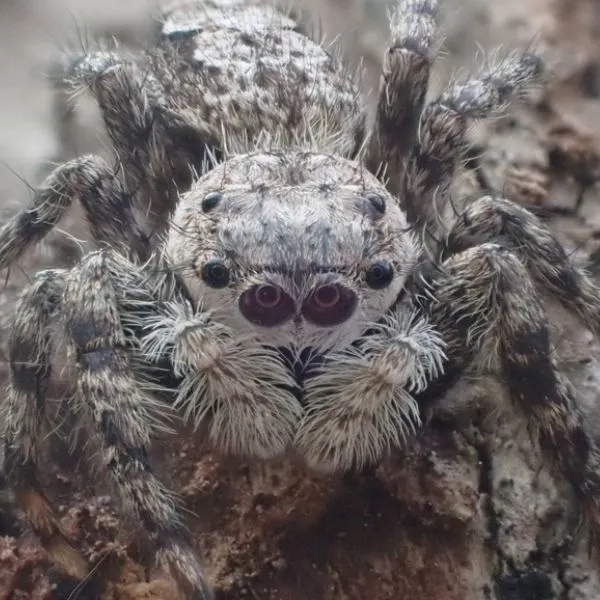
- Experience Level: Beginner
- Family: Salticidae
- Scientific Name: Platycryptus undatus
- Other Names: n/a
- Adult Size: 8.5 to 13 mm (0.33 to 0.51 inches)
- Lifespan: 1 year
- Average Price Range: $20 to $30
Tan jumping spiders are a small furry species named after their coloring. This brown species has a mottled pattern on it and is covered in various shades of brown.
Males and females look very similar, but females are a bit larger than males. This species has a flat body, useful in hiding in places like tree bark. Small hairs cover this spider’s entire body.
A common species in Kentucky, this species has a range that covers the eastern United States. They spend their time on vertical surfaces like walls, trees, and fences.
The tan coloring and wavy pattern on this spider help them camouflage into their settings. This spider can be seen during the day, and at night they build a silk nest in a secluded area to rest.
Summer is when this spider lays eggs, and they lay their eggs in their sacs. Eggs take around 3 to 4 weeks to hatch, and a jumping spider is capable of laying over 100 eggs.
Males court females by waving their arms, and tapping the ground, performing a dance to get their potential mates’ attention. If the female is uninteresting she will flee.
The tan jumping spider uses its eyesight and fast leaps to prey on small insects. They feed on insects like flies, aphids, and sometimes smaller spiders.
They tend to avoid hunting animals that have things like fangs or pincers and will be extra wary if they decide to prey on them.
22. Regal Jumping Spider
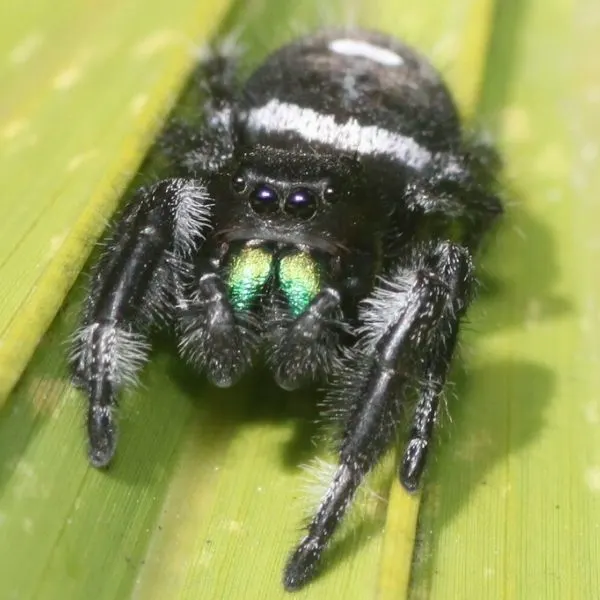
- Experience Level: Beginner
- Family: Salticidae
- Scientific Name: Phidippus regius
- Other Names: n/a
- Adult Size: 6 to 18 mm ( 0.23 to 0.70 inches)
- Lifespan: 1 to 2 years
- Average Price Range: $30
The regal jumping spider is a large species, as the spiders from the Phidippus genus are larger than other species of Salticidae. Female regal jumping spiders have orange or tan coloring.
Males are all black, with white tufts of hair on them, and have large vibrant blue chelicerae. Females have orange or tan coloring and are covered with plenty of hair.
The abdomen of this spider has three blotches on them, that are either white or orange in color. Males of this species look very similar to the bold jumping spider, but this species is slightly larger.
Regal jumping spiders are a widespread species that was first discovered in the southeastern United States. This species lives in open woodland and field habitats and is active during the day.
At night this spider rests in a silk nest to rest in. Humid and warm temperatures are preferred by this species, and they spend their day moving around vegetation.
Regal jumping spiders are a harmless species, and bites from them may only lead to some mild swelling unless allergic reaction. This spider will likely flee if spotted and uses its jumps to flee.
Like other jumping spiders this species is able to jump 10 times its body length. They are adept hunters and use their keen eyesight and quick jumps to take down their small insect prey.
23. Canopy Jumping Spider
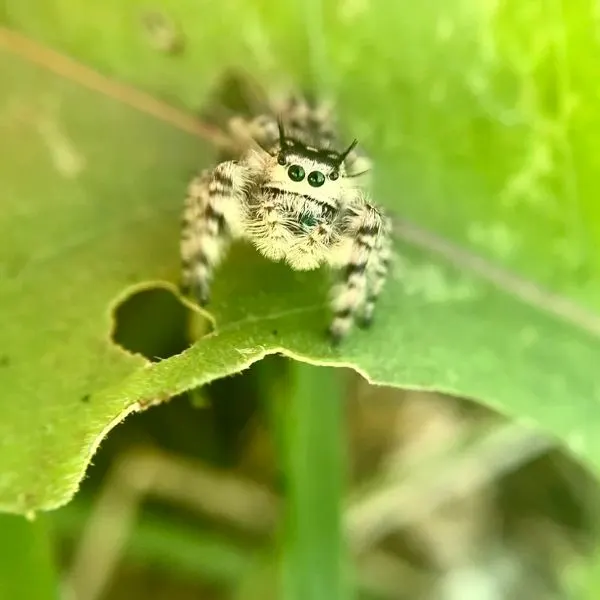
- Experience Level: Beginner
- Family: Salticidae
- Scientific Name: Phidippus otiosus
- Other Names: n/a
- Adult Size: 8 to 16 mm (0.31 to 0.62 inches)
- Lifespan: 1 year
- Average Price Range: $20 to $30
Canopy jumping spiders are one of the largest species found in Kentucky. This species has black coloring, with white, orange, or gray hair on them.
Bands appear on this spider’s legs, and they have blotched markings on their back. The chelicerae of this spider are large, with vibrant green iridescent coloring.
The canopy jumping spiders are found in the eastern United States and spend their lives in trees. They also have populations in other countries like Germany or Sweden but are native to the US. Pine forests and other woodland habitats are where you may find this species in Kentucky.
Winter is when this spider begins to mate, and as many as 150 eggs can be laid by a female. Eggs begin to hatch in the summer, and the young spiderlings fully mature in the fall.
Canopy jumping spiders feed on small insects they come across, like flies, moths, and beetles. This spider uses its eyes to track its prey and pounces on them with its fast jumps.
Canopy jumping spiders are a harmless species, and if spotted by humans they flee. This spider is active during the day, and in the wild has predators like larger spiders and birds that also inhabit trees.
24. Rabbit Hutch Spider
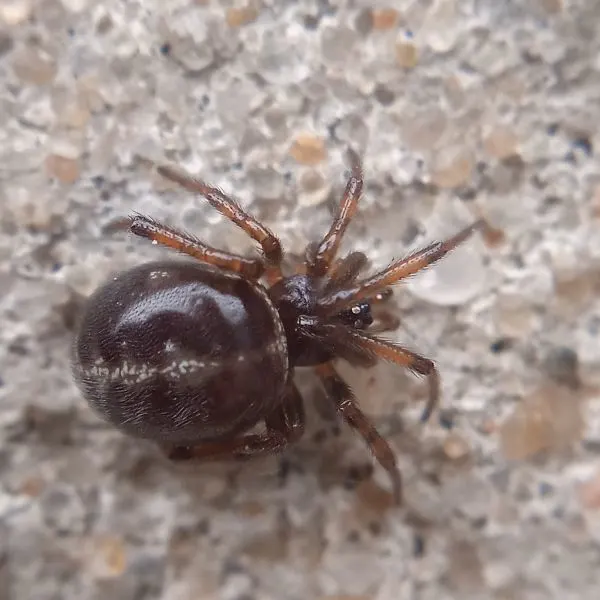
- Experience Level: Intermediate
- Family: Theridiidae
- Scientific Name: Steatoda bipunctata
- Other Names: n/a
- Adult Size: 16 mm (0.75 inches)
- Lifespan: 1 year
- Average Price Range: n/a
The rabbit hutch spider has a large round abdomen and spindly legs. This spider has a dark brown coloration, with a greasy appearance.
They have a wax-like appearance on their body. Rabbit hutch spiders have cream markings on their body. Males and females look similar, but females are larger.
This species gets its name since it is regularly found in the cages of rabbits. They build messy cobwebs to live in and are commonly found near humans.
Rabbit hutch spiders are active year-round. This species builds its messy webs in secluded areas that are around man-made structures.
If this spider is in a rabbit hutch it helps kill insects that may annoy the rabbit-like mosquitoes and flies, giving the bunny a more peaceful setting. This spider feeds on insects that get caught in its messy web and use its venom to kill its prey.
Rabbit hutch spiders are harmless to humans, and are not an aggressive species.
25. Triangulate Cobweb Spider
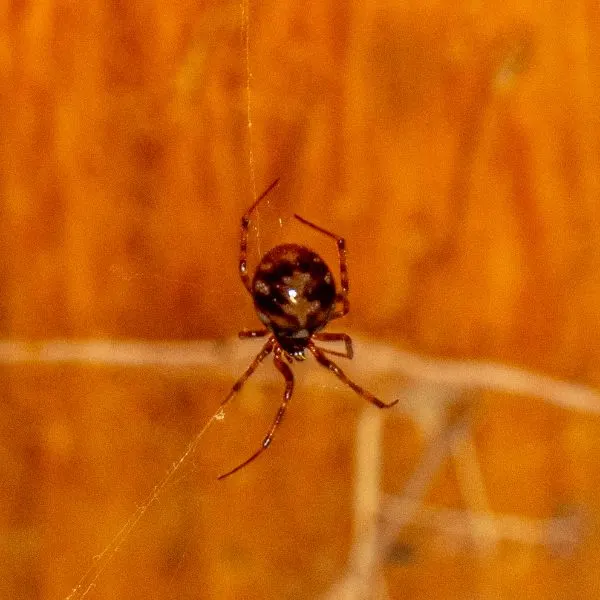
- Experience Level: Intermediate
- Family: Theridiidae
- Scientific Name: Steatoda triangulosa
- Other Names: Triangulate bud spider
- Adult Size: 3 to 6 mm (0.1 to 0.23 inches)
- Lifespan: 1 to 3 years
- Average Price Range: n/a
The triangulate cobweb spider has a round abdomen, and spindly legs, similar to other Theridiidae spiders.
This species has brown or black coloring, with cream and dark markings on its body. Their legs have dark bands on them, and they are covered in tiny hairs.
Triangulate cobweb spiders are common in North America and have a large round around the globe. This spider creates a messy web to live in, and lives inside homes, basements, and other man-made structures. This species is active year-round and will build its web in a secluded area to avoid being disturbed.
This spider does not have good eyesight and uses the vibrations from its silk to sense things. They feed on insects like pill bugs and roaches that get caught in their web.
Triangulate cobweb spiders have venom that may cause symptoms like nausea, and redness if bit, but this species is generally harmless.
26. Common House Spider

- Experience Level: Beginner
- Family: Theridiidae
- Scientific Name: Parasteatoda tepidariorum
- Other Names: American House Spider
- Adult Size: 3 to 5 mm (0.11 to 0.19 inches)
- Lifespan: 1 to 2 years
- Average Price Range: n/a
Found all across the globe, the common house spider is a species you may come across in Kentucky, and other areas with man-made structures. This species has a body shape similar to a black widow.
They have brown coloring, and a mottled pattern covering them. Males of this species are much smaller than females but have a similar appearance.
The common house spider lives in homes, garages, warehouses, and other man-made buildings. This species builds messy webs to live in.
They are active year-round and are also found outdoors. This spider prefers damp and dark places for its web.
Insects like pillbugs, ants, and other spiders are some of the things this species eats. Even though this species lives in homes it does not bite humans often, but if a bite does occur it only has mild symptoms.
Common house spiders are preyed on by lizards, other larger spiders, and humans.
27. False Black Widow
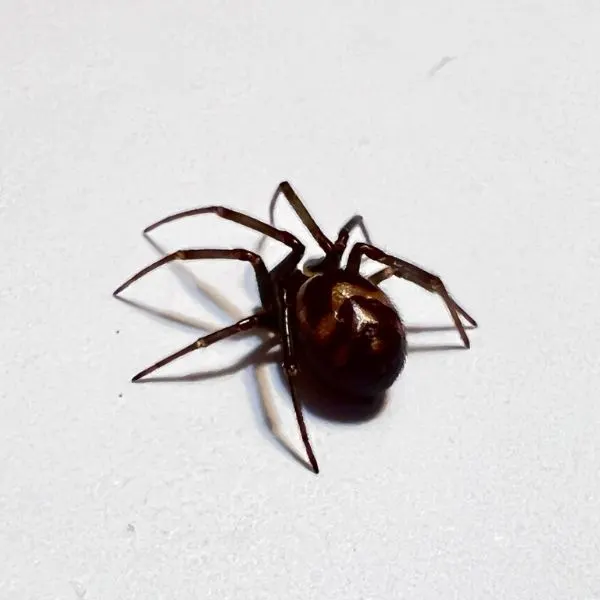
- Experience Level: Beginner
- Family: Theridiidae
- Scientific Name: Steatoda grossa
- Other Names: Brown House Spider, Cupboard Spider
- Adult Size: 10 to 14 mm (0.39 to 0.55 inches)
- Lifespan: 2 to 6 years
- Average Price Range: n/a
False widows spider get their name image they look like a member of Latrodectus. This spider has a round abdomen and dark brown coloring.
False widows have my dark coloring. False widows are not members of Latrodectus, but they have to give them a serious appearance.
False widows line in a secluded area and create messy webs similar to the black widow. While these spiders look like black widows, they are not widow spiders. This species is a part of the same family as the black widow.
False widows create their messy webs in corners and feed on insects that get caught in the trap. They have venom they use to take down their prey, which is only mildly harmful to humans.
Bites from this species can cause nausea and other symptoms, and Latrodectus venom has been shown to work for treatment.
28. Northern Black Widow
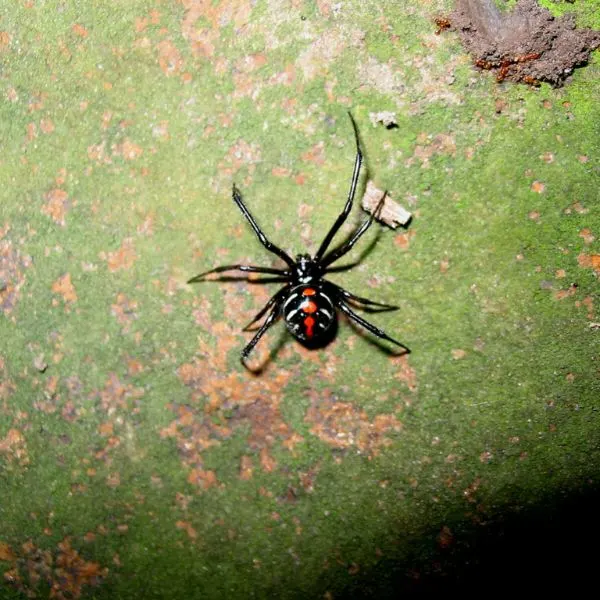
- Experience Level: Intermediate
- Family: Theridiidae
- Scientific Name: Latrodectus variolus
- Other Names: Northern Widow
- Adult Size: 12.7 to 15.24 mm (0.5 to 0.6 inches)
- Lifespan: 1 to 3 years
- Average Price Range: $20
The northern black widow is one of the most dangerous spiders in Kentucky.
This spider lives in the U.S. and is also found in parts of Canada. They are active mostly in the warm months of summer and fall, and they are a nocturnal species.
Northern black widows build messy webs to live in and are active at night. They build their webs in places like outdoor furniture, kids’ toys, and underwater spouts.
Northern black widows have black coloring, and a red hourglass marking on them. Male black widows are much smaller than females and have sleek bodies.
Females are known for their round abdomens and spindly legs. This species looks nearly identical to the southern black widow, but they have a broken hourglass mark on them.
Northern black widows have extremely potent venom that targets the body’s nervous system. This spider causes latrodectism, which causes nausea, vomiting, shaking, and other symptoms.
Deaths from this spider are rare due to anti-venom, and how little venom is injected into humans.
29. Southern Black Widow

- Experience Level: Intermediate
- Family: Theridiidae
- Scientific Name: Latrodectus mactans
- Other Names: Shoe-button spider
- Adult Size: 8 to 13 mm (0.3 to 0.5 inches)
- Lifespan: 1 to 3 years
- Average Price Range: $20
Southern black widows are some of the most dangerous spiders in Kentucky.
This species has venom that is 15 times stronger than that of a rattlesnake, but their venom is administered in much smaller amounts so it is less deadly. Southern black widows have slightly more potent venom and are also more aggressive in nature.
This species is active in the summer and fall months. They have all black coloring, and females are easily identifiable by the hourglass marking that appears on the underside of their abdomen. They build their web in dark and secluded areas and can be seen hanging in them in the evening and night.
Southern black widows rarely kill since there is antivenom, but their bites come with a myriad of symptoms. Older and younger humans are more susceptible to their bite.
This species will only bite if provoked and is not aggressive toward humans.
30. Long-bodied Cellar Spider
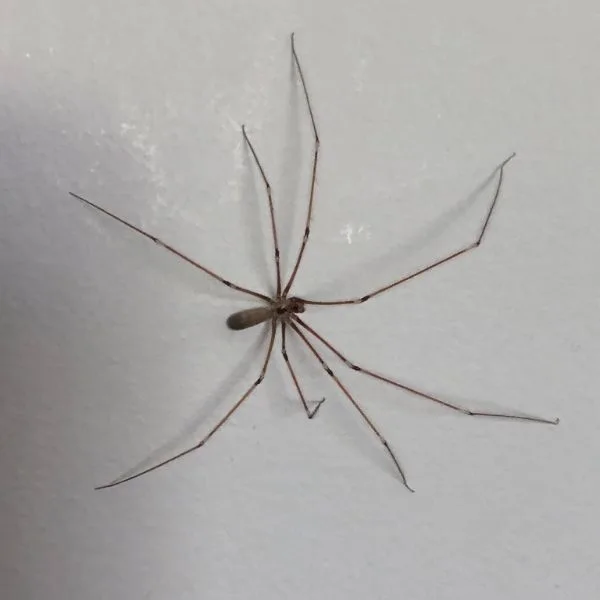
- Experience Level: Intermediate
- Family: Pholcidae
- Scientific Name: Pholcus phalangioides
- Other Names: Skull spider, Daddy long-leg spider
- Adult Size: 6 to 10 mm (0.23 to 3.9 inches)
- Lifespan: 1 to 3 years
- Average Price Range: n/a
The long-bodied cellar spider is one of the most common spiders in the United States, and in Kentucky. This species is active year-round and lives in loose webs they create.
It is not uncommon to find this species living in a communal web with other spiders. They build their webs in man-made structures like garages, houses, backyards, and also dark places like caves.
This species is also called the daddy long leg to due its long and thin legs that make up most of its body. This spider is tan, with an elongated abdomen. They have dark bands on their legs and are a very sleek species.
This spider catches insects and other spiders in its web, killing anything that gets close to it. They are able to take out dangerous species like the black widow, or brown recluse easily due to their speed and size.
This spider quickly wraps up its prey and injects them with venom. Cellar spiders usually don’t bite, since their fangs are too weak to pierce human skin.
31. Bowl and Doily Spider

- Experience Level: Intermediate
- Family: Linyphiidae
- Scientific Name: Frontinella pyramitela
- Other Names: n/a
- Adult Size: 4 mm (0.16 inches)
- Lifespan: 1 year
- Average Price Range: n/a
The bowl and doily spider is a species named after its weirdly-shaped web. This spider’s web has a flat doily section on top and a bowl section where the spider sits.
This species is active from spring to fall and builds its webs on vegetation like bushes, and other low-lying plants. Their webs are what makes them easily identifiable, and you will often see multiple bowl and doily spiders close to each other.
This spider is small and has dark brown coloring with white markings on them. It waits on the underside of its bowl web and pulls in insects when they get caught in the silk. The doily section of this spider’s web is used to push insects further into its silk.
This spider’s web is designed to catch many insects and keep them safe in the process. They live in woodlands and open grassland-type habitats.
This spider kills its prey with venom, but they are extremely harmless to humans, with bites rarely occurring.
32. Brown Recluse

- Experience Level: Intermediate
- Family: Sicariidae
- Scientific Name: Loxosceles reclusa
- Other Names: Violin spiders
- Adult Size: 7 mm (0.27 inches)
- Lifespan: 1 to 2 years
- Average Price Range: n/a
Brown recluses are one of the most dangerous spiders in Kentucky. This spider has tan coloring and is identifiable by the dark vision found on its carapace.
There are no other distinguishing markings on this spider, as they have a fairly plain look. Males have longer legs, while females have bigger abdomens.
Woodlands and urban areas are where brown recluses are common. Summer and fall are when this spider is active most.
They are nocturnal and wander at night. Brown recluse spiders hide under debris like cardboard, logs, and leaf litter to rest during the day.
Brown recluse spiders feed on insects at night and use their powerful venom to kill their prey. This spider’s venom kills the cells, skin, and tissue of the area that is bitten.
Amputations can happen in worst-case scenarios, and death is possible but rare.
33. Yellow Sac Spider

- Experience Level: Intermediate
- Family: Cheiracanthiidae
- Scientific Name: Cheiracanthium mildei
- Other Names: Long-legged Sac Spider
- Adult Size: 5 to 10 mm (0.19 to 0.39 inches)
- Lifespan: 1 to 2 years
- Average Price Range: n/a
The yellow sac spider has a color that ranges from light yellow to beige.
This species has a body shape similar to the brown recluse, as it has a round abdomen and long thin legs. The fangs of this spider are large for their size and black.
Yellow sac spiders live in gardens, forests, and urban habitats. They are active at night, and in the day hide under debris and vegetation. This species may wander into homes, and hide under things like dirty laundry, and cardboard.
Yellow sac spiders build a silk sac to rest in during the day, hence their name. This species hunts insects at night and uses their venom to neutralize its prey.
This spider has necrotic venom which can cause a small lesion if you are bit by it. Yellow sac spiders are not dangerous but may leave a wound.
Since they come indoors often bites happen unsuspectingly more than other species.
34. Long-palped Ant-mimic Spider
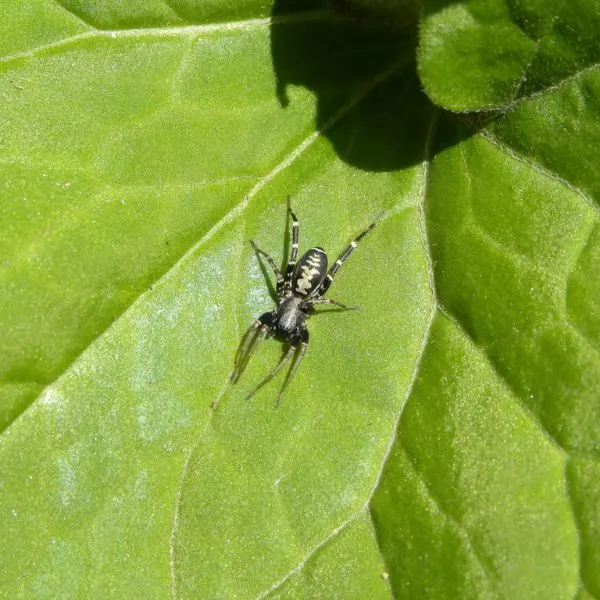
- Experience Level: Intermediate
- Family: Corinnidae
- Scientific Name: Castianeira longipalpa
- Other Names: n/a
- Adult Size: 3 to 13 mm (0.11 to 0.51 inches)
- Lifespan: 1 to 2 years
- Average Price Range: n/a
Black is the color of the long-palped ant-mimic spider. They have a yellow or cream mottled pattern on their carapace, and white markings on their abdomen.
Their back legs have white bands, and other legs have dark coloring on the tip of their feet. This spider is small and mimics an ant.
The long-palped ant-mimics walks with its two front legs up and moves slowly to look like an ant. They live in a variety of habitats and move amounts of leaf litter, rocks, and logs on the ground.
Long-palped ant mimic spiders can be found in places like laws, fields, and gardens. They feed on ants and mimic them to get close enough to take them out.
This spider also eats other small insects and small spiders.
35. Woodlouse Spider
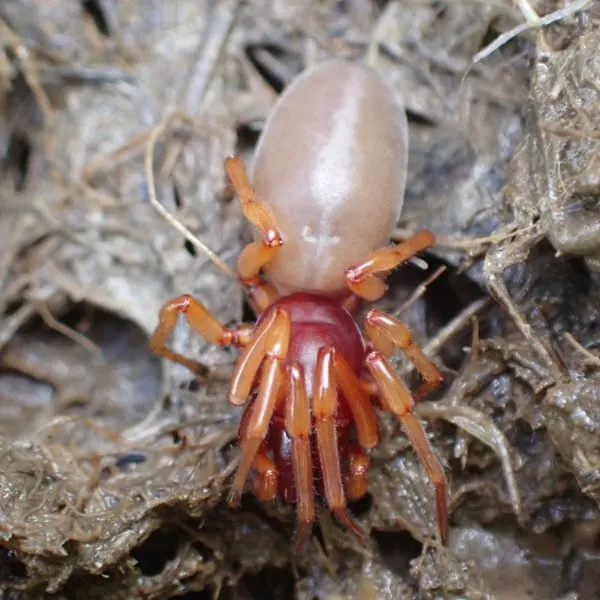
- Experience Level: Beginner
- Family: Dysderidae
- Scientific Name: Dysdera crocata
- Other Names: Woodlouse hunter, sowbug killer
- Adult Size: 9 to 3 mm (0.35 to 0.59 inches)
- Lifespan: 2 to 5 years
- Average Price Range: n/a
The woodlouse spider has a large bright head, with a tan abdomen. Their legs also have red coloring, and their fangs are very large.
Males and females of this species look very similar, but females are a bit bigger. Woodlouse spiders have large fangs to help them feed on woodlice which is one of their primary food sources.
Woodlouse spiders can be found in Kentucky and other parts of the United States. This spider also lives in parts of Europe and Australia.
Woodlouse spiders live in dark and moist places. They are active at night and will create a silk sac to rest in.
Woodlice are one of the main foods of this spider since they both live in the same areas. Other spiders and insects are also preyed on by the woodlouse spider, and they do not have any preference for what they feed on.
These spiders’ large fangs give a painful bite, and since they feed on dead animals infection is possible if bitten.
36. Red-spotted Ant-mimic Spider

- Experience Level: Intermediate
- Family: Corinnidae
- Scientific Name: Castianeira descripta
- Other Names: n/a
- Adult Size: 13 mm (0.51 inches)
- Lifespan: 1 to 2 years
- Average Price Range: n/a
On the abdomen of the red spotted ant mimic spider is a red marking, similar to that of a red back spider. They have all black coloring and thick legs.
Some may confuse this spider for a black widow, but they lack the red hourglass marking on their abdomen. The red-spotted ant mimic spider is said to mimic the appearance of a velvet ant.
This species walks with its two front legs up like antennae, and very slowly to look like an ant to other small animals. This species lives in areas like parks, gardens, and backyards where you may see this spider in Kentucky.
Red-spotted ant-mimic spiders feed on small insects and ants. By copying an ant they are able to get close to them and eat them.
This spider is harmless to humans, and its bites are similar to that of a bee sting.
37. Eastern Parson Spider
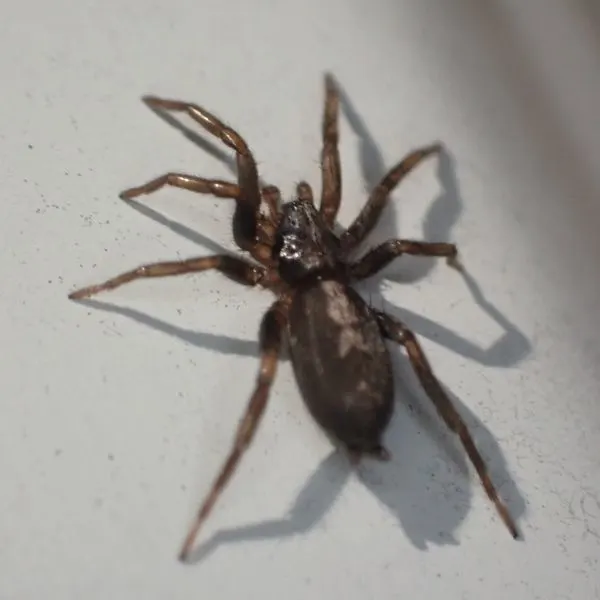
- Experience Level: Intermediate
- Family: Gnaphosidae
- Scientific Name: Herpyllus ecclesiasticus
- Other Names: n/a
- Adult Size: 5 to 12.7 mm (0.2 to 0.5 inches)
- Lifespan: 1 to 2 years
- Average Price Range: n/a
The eastern parson spider can be found in the eastern United States. This species has a black abdomen and cephalothorax, with a white marking running down its center.
They have a white marking near the tip of their abdomen and a spinneret tail. The legs of this spider are long, and they have dark brown coloring on the tips of their legs.
Eastern parsons spiders are native to the United States and are a ground-dwelling species. This spider is active at night, and during the day it will hide in a silk retreat.
At night this spider spends its time hunting and preying on small insects. They feed on other small animals they find in the first habitats they live in.
This spider also lives in urban areas and may make its way into homes looking for food. Bires for this species can be painful but are only dangerous if there is an allergic reaction to this spider’s venom.
38. Garden Ghost Spider
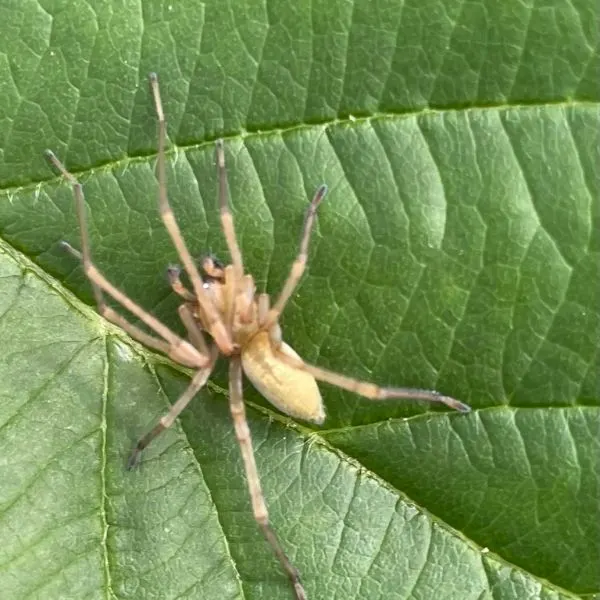
- Experience Level: Intermediate
- Family: Anyphaenidae
- Scientific Name: Hibana gracilis
- Other Names: n/a
- Adult Size: 4 to 8 mm (0.15 to 0.31 inches)
- Lifespan: 1 year
- Average Price Range: n/a
The garden ghost spider is a species that inhabits the U.S. and lives in states like Kentucky.
This species and other ghost spiders get their name from their pale coloring, and they also have a mottled pattern on them. Gardens and other vegetated habitats are where this species lives.
Garden ghost spiders are nocturnal and explore the vegetation they live around. During the day this spider rests in a silk retreat under rocks, logs, and in other secluded areas. The spring and fall are when this spider is most active.
Garden ghost spiders occasionally may feed on nectar to give them energy, but they also hunt for insects at night. This spider is good for gardens since it will eat any pest insects that feed on plants.
39. Running Crab Spider
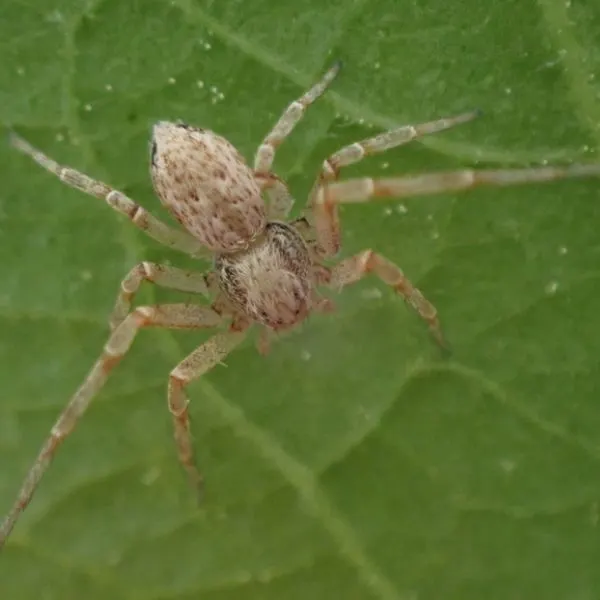
- Experience Level: Beginner
- Family: Philodromidae
- Scientific Name: Philodromus spp.
- Other Names: n/a
- Adult Size: 38 mm (1.5 inches)
- Lifespan: 1 year
- Average Price Range: n/a
A very fast and agile species, the running crab spider looks similar to that a huntsman spider. This species has a mottled pattern of light and dark brown on it and is covered in tiny hairs.
On the front of their face are eight small eyes. This spider has a round abdomen and long legs. Their legs spread out from their body, and are positioned like a crab.
This species lives in woodland, and forest habitats, and uses its coloring to camouflage into the ground. This spider uses its speed to prey on insects and kills them with its venom.
Running crab spiders are not a member of the crab spider family, but are called crab spiders because of their leg shape.
40. White-banded Crab Spider
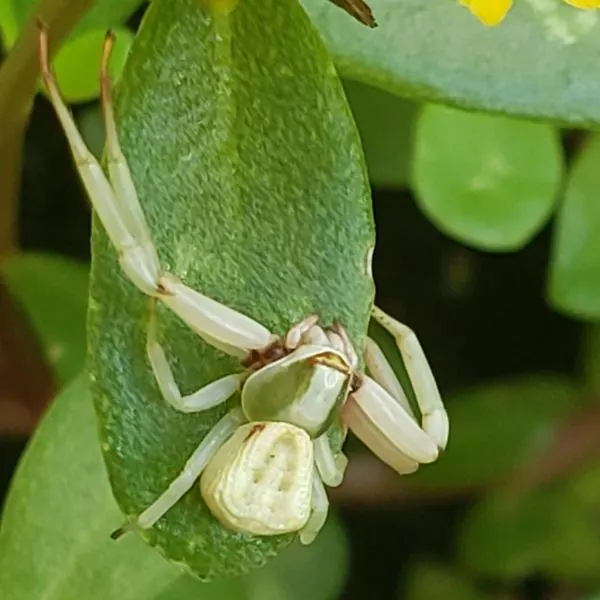
- Experience Level: Intermediate
- Family: Thomisidae
- Scientific Name: Misumenoides formosipes
- Other Names: n/a
- Adult Size: 3 to 11 mm (0.11 to 0.43 inches)
- Lifespan: 1 year
- Average Price Range: n/a
The white-banded crab spider gets its name from the white band that appears running down this spider’s carapace. This species is sexually dimorphic.
Males are smaller and have a golden color with dark brown legs. Females have large round abdomens and large crab-like legs.
Females can have markings like lines or blotches on them. They have yellow or white coloring and are able to change between the two.
Meadows, gardens, and grasslands are common places where this spider is found. They live on flowering plants and use their coloring to blend into their surroundings. This spider is active during the day, and adults can be found in the months of summer and fall.
White-banded crab spiders wait on flowers to catch prey like bees, butterflies, and wasps. They grab them with their strong front claws and kill them with their venom.
This spider is like other crab spiders and gets its name from its crab-like body shape and the crabby way they move.
41. Spitting Spider

- Experience Level: Intermediate
- Family: Scytodidae
- Scientific Name: Scytodes thoracic
- Other Names: n/a
- Adult Size: 6 to 18 mm (0.25 to 0.75 inches)
- Lifespan: 1.5 to 4 years
- Average Price Range: $30
Spitting spiders are a tan species, covered in dark blotches and stripes. This spider has long thin legs, and a round head and abdomen.
While spiders usually have eight eyes, this spider has six, arranged groups of twos on its face. The two front legs of this spider are long, which helps them aim.
What makes this spider unique is its ability to spit a liquid venom, and silk substance at its prey. They are able to spit a quick 28 meters per second and spit from a distance of around 0.7 inches. In Kentucky and other areas of the eastern United States is where this spider is found more often.
Spotting spiders are nocturnal, and in the day they hide in areas like under rocks, and in other dark crevices. Forests, urban areas, and open woodlands are habitats where this species lives.
They use their spit to wrap up prey like other spiders, flies, and mosquitoes. Occasionally this spider makes its way into homes, but it is harmless to humans.
42. American Grass Spider

- Experience Level: Beginners
- Family: Agelenidae
- Scientific Name: Agelenopsis
- Other Names: funnel weavers
- Adult Size: 9 to 20 mm (0.35 to 0.78 inches)
- Lifespan: 1 to 2 year
- Average Price Range: n/a
Grass spiders are a very common species in Kentucky, found living on the state’s various vegetation.
This spider is small and has brown coloring. They have two bold stripes that appear on their carapace, and on their abdomen is a mottled pattern of dark brown stripes.
This spider looks similar to a small wolf spider but has a sleeker appearance. At the end of their abdomen is a spinneret tail which helps this species make its funnel web.
American grass spiders are a widespread species in Kentucky and are one of the most common species in the United States. This spider lives in the grass as its name suggests, and builds a flat web with a funnel retreat. Their web is sometimes built on flowers, lawns, and other plants.
This spider is extremely fast and quickly grabs anything that gets on its web. They are covered in many small hairs which help them sense vibrations better.
Spring to fall is when you can spot this species, and they are a nocturnal species.
43. American Nursery Web Spider

- Experience Level: Intermediate
- Family: Pisauridae
- Scientific Name: Pisaurina Mira
- Other Names: n/a
- Adult Size: 15 mm (0.59 inches)
- Lifespan: 2 years
- Average Price Range: $10
The American nursery web spider is found in Kentucky and is a common spider in the eastern US.
This spider has tan coloring and a bold dark brown marking that runs from the top of its carapace to the tip of its pointed abdomen. American nursery web spiders are often confused with fishing spiders, but this species has a much sleeker appearance.
Areas with lots of vegetation, and water nearby is where this species can be found. Woodlands, grasslands, and other similar habitats are common places they are seen in Kentucky. These spiders have a large range and can also be found in other areas in Europe.
American nursery web spiders get their name since females create a nursery with their silk to house their young when they hatch.
The summer is when this species mates and the female will carry her egg sac similar to some species of fishing spiders and wolf spiders. When the spiderlings hatch they remain in their nursery for around a week, then they go off into the wild.
Like other Pisauridae spider species, nursery web spiders can walk on water, and dive to chase or flee from other animals. They hunt small animals like tadpoles, small frogs, and insects.
This spider faces an array of predators like wasps, fish, other spiders, birds, lizards, and frogs. American nursery web spiders are harmless to humans, and their venom is only strong enough to kill the prey they eat.
44. Striped Fishing Spider
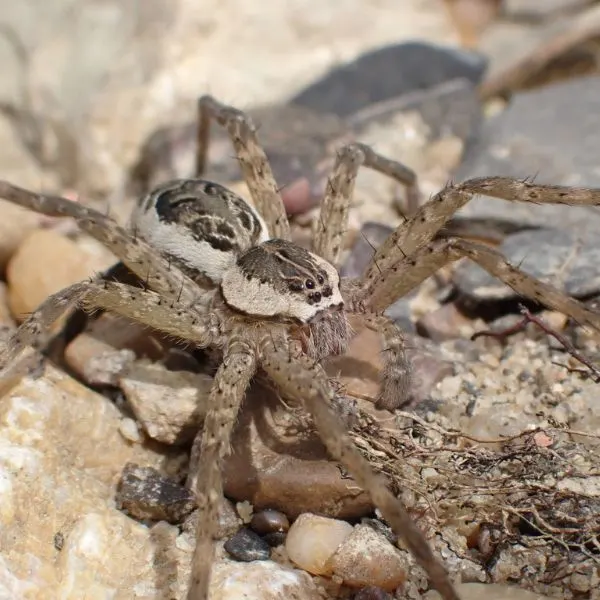
- Experience Level: Intermediate
- Family: Pisauridae
- Scientific Name: Dolomedes scriptus
- Other Names: n/a
- Adult Size: 15 to 60 mm (0.59 to 2.3 inches)
- Lifespan: 2 years
- Average Price Range: n/a
The striped fishing spider is one of the few species of fishing spiders that live in Kentucky. This spider has light to dark tan coloring, with W markings going down its abdomen.
Striped fishing spiders have long legs, and pointed abdomens. A stripe runs down the center of this spider’s round carapace.
Striped fishing spiders look very similar to dark fishing spiders. Striped fishing spiders have lighter coloring, with a lighter shade between their W markings on their abdomen.
Striped fishing spiders live in moist habitats, usually next to a body of water like a lake, pond, or creek. This spider is able to walk on water and is also covered in hydrophobic hairs. The legs of this spider do not break the water’s tension, which lets them traverse water surfaces.
Striped fishing spiders are active mostly in the summer months, and come out at night. Their night is spent hunting for prey both on land, and water. This spider is able to dive under the water to feed on small fish, or tadpoles, and also eat the aquatic insects they come across.
Traveling on and in the water helps fishing spiders escape predators like birds, but they can be preyed on by fish, frogs, and other spiders.
45. Dark Fishing Spider
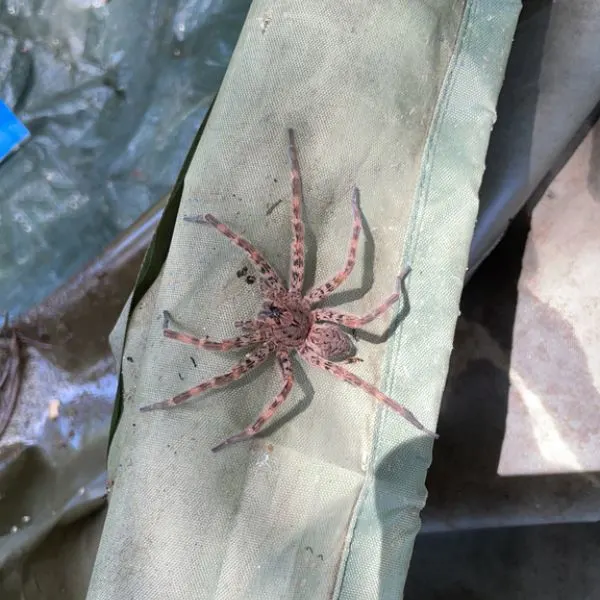
- Experience Level: Intermediate
- Family: Pisauridae
- Scientific Name: Dolomedes tenebrosus
- Other Names: n/a
- Adult Size: 6.8 to 25.4 mm (0.27 to 1 inch)
- Lifespan: 2 years
- Average Price Range: n/a
The dark fishing spider is a larger spider found in Kentucky and is often confused for being a wolf spider. This species has grayish to light tan coloring and is covered in a dark mottled pattern.
Their legs stretch out to their sides like a fan, and their carapace has a rounded shape. Hairs cover this spider’s entire body, and they have a W pattern that appears on their abdomen.
Dark fishing spiders live in habitats such as woodland, marshes, and other forested habitats. While it is common to find this spider near freshwater sources like ponds or lakes, they may also wander away from any water.
This spider is active from the months of spring to fall and is nocturnal. During the day this spider hides in a dark and moist secluded area, such as under leaf litter.
Dark fishing spiders spend most of their night hunting for insects, and other small animals that they can feed on. Their tannish coloring and pattern are not only for looks, but help them camouflage into things like wooden structures, and dirt.
Tadpoles, small fish, and water bugs are a few of the things this spider eats. Frogs, fish, and spiders prey on the dark fishing spider, but they can use the water to escape.
This spider is harmless to humans unless allergic, and this larger spider would likely flee if approached.
46. Six-spotted Fishing Spider
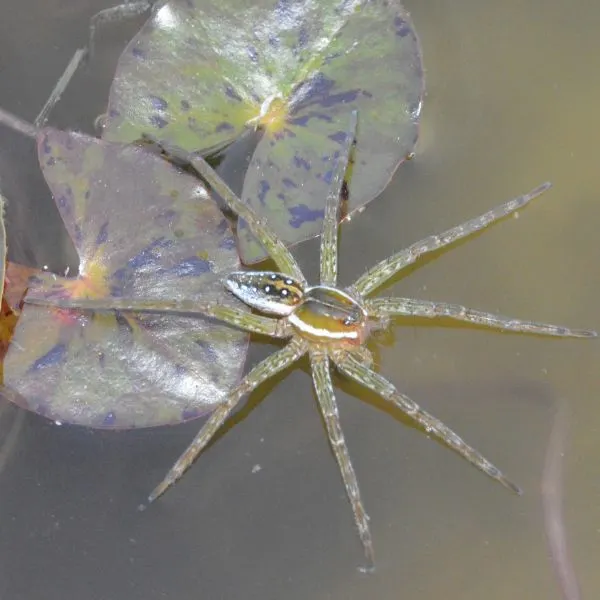
- Experience Level: Intermediate
- Family: Pisauridae
- Scientific Name: Dolomedes triton
- Other Names: Dock Spiders
- Adult Size: 15 to 20 mm (0.59 to 0.7 inches)
- Lifespan: 2 years
- Average Price Range: $20
The six-spotted fishing spider is one of the many species of nursery web spiders that live in Kentucky. They are named after the six spots that appear on the underside of their abdomen.
Six-spotted fishing spiders have gray, or brown coloring. A white bold stripe runs down the sides of their abdomen and carapace. White spots also appear in two rows on the abdomen of this spider.
Six-spotted fishing spiders live in moist vegetated habitats. Forests, swamps, and moist woodlands are a few habitats they prefer.
Six-spotted fishing spiders are active from the spring to fall months. They are a nocturnal species and spend their night wandering around the vegetated areas they live in.
Fishing spiders are active hunters and do not catch insects with their webs like some spiders such as orbweavers. They have an excellent vision which they use to kill their prey.
Aquatic prey like small frogs, fish, and water insects are what these spiders hunt for when they traverse across the water. Like other fishing spiders, it is semi-aquatic and is able to dive underwater for short periods of time.
This spider also uses the water to escape predators like fish, frogs, and other spiders.
47. Tiger Wolf Spider
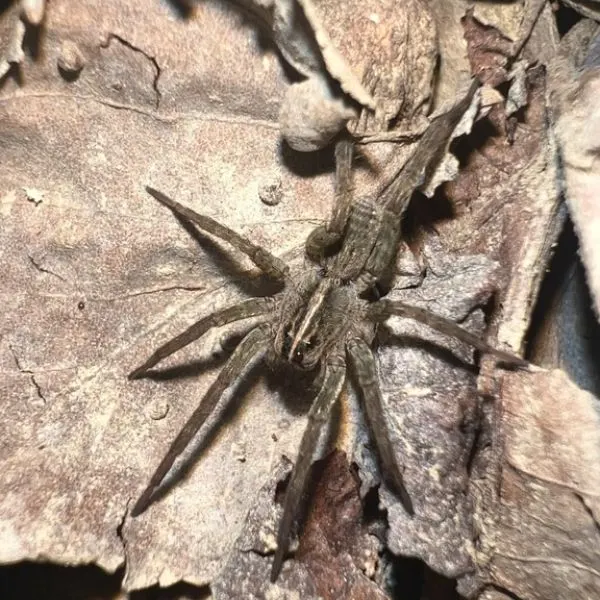
- Experience Level: Beginner
- Family: Lycosidae
- Scientific Name: Tigrosa helluo
- Other Names: Wetland Giant Wolf Spider
- Adult Size: 6.3 to 50 mm (0.24 to 1.9 inches)
- Lifespan: 1 to 4 years
- Average Price Range: $20 to $40 dollars
Tiger wolf spiders are one of the largest spiders in Kentucky and are one of the members of the Lycosidae family that you can find in the state.
This species has tan coloring, with a yellow stripe that ruins down from its eyes to the end of its carapace. The underside of this species is covered in black spots, and they may also have some spots that appear on their abdomen.
Tiger wolf spiders live in woodlands, marshes, grasslands, and other vegetated moist habitats where this species can be found in Kentucky. Tiger wolf spiders are active in the warm months of spring and fall. They are active at night, and during the day they hide in a secluded area like under leaf litter or in burrows.
Tiger wolf spiders hunt on a variety of ground-dwelling animals at night. Other spiders, small frogs, and other invertebrates. This species is very speedy and will flee if spotted.
Predators like birds, wasps, and prey mantises are what hunt this species. They are also preyed on by other spiders, and sexual cannibalism is common when mating occurs.
Tiger wolf spiders are harmless, and bites from them only cause mild swelling and slight pain.
48. Rabid Wolf Spider

- Experience Level: Beginner
- Family: Lycosidae
- Scientific Name: Rabidosa rabida
- Other Names: n/a
- Adult Size: 13 to 21 mm (0.511 to 0.82 inches)
- Lifespan: 1 to 4 years
- Average Price Range: $40
A medium-sized species, the rabid wolf spider has brown coloring. The abdomen of this species has light and dark stripes on it, with a pointed shape.
Their head has two dark stripes on them. The eyes of this species are placed at the front of their face and shine at night when flashed with light.
This spider is native to North America and is common in woodlands, forests, fields, and urban areas. This species is active at night, and during the day they hide in a burrow, under leaf litter, or in other similar areas.
This spider is active most in the summer and fall months. The rabid wolf spider drags their egg sac around until it is ready to hatch. The spiderlings that come out of their egg sac will climb onto their mother’s back until they disperse to tackle the world.
Wolf spiders like this species are named after their quick speed and wolf-like hunting ability. This spider is extremely quick and uses its speed to take out its prey.
Rabid wolf spiders get their name from their crazy speed and movements, similar to rabid animals. If you spot this spider in the wild it can quickly get out of sight before you can get a good look at them.
49. Red-legged Purseweb Spider

- Experience Level: Intermediate
- Family: Atypidae
- Scientific Name: Sphodros rufipes
- Other Names: n/a
- Adult Size: (0.4 to 1.5 inches)
- Lifespan: 4 to 7 years
- Average Price Range: N/A
The purseweb spider is not seen often but is one of many spiders in Kentucky. This species has dark black coloring and a very robust body.
Males of this species have bright red legs, which lets them look more dangerous to other animals while they wander looking for a mate. Females are all black and have stocky bodies. The fangs on the purse web spider are more sizable than most, and they can deliver a painful bite.
Red-legged purseweb spiders live in forest habitats, but may also be found in urban regions. Purseweb spiders live in tubular structures that they build, which are found on things like rocks and trees.
The life of this spider is spent mostly in its silk tube. Males leave their tubes to mate, which occurs in the summer. Cannibalism occurs when males attempt to mate sometimes, as their bodies are sometimes seen in a female’s tube.
One of the main purposes of the red-legged purse spider tubed home is its use to catch insects. This spider will wait near its silk and pull in insects that walk on its tube to feed on them.
Predators of this species include birds and small mammals.
FAQ
What are the Most Dangerous Spiders In Kentucky?
In Kentucky, the most dangerous species in the state are the brown recluse, the northern black widow, and the southern black widow.
Black widows have neurotoxic venom, while the venom of the brown recluse has necrotic properties. Bites from these spiders may require medical treatment, and there is only anti-venom for a black widow’s bite.
Black widow bites cause symptoms like nausea, vomiting, and chills. Brown recluse spider bites kill the skin, cells, and tissue in the area that is bitten. Symptoms vary and depend on the person that is bitten.
Black widows and brown recluses’ venom is more powerful than the other spiders that live in Kentucky. These spiders are not aggressive, and will only bite if provoked.
Other spiders do not have venom that is medically significant to humans, or their bite is comparable to a bee sting.
When are Spiders Active in Kentucky?
Spring to fall is when spiders are active in Kentucky. The winter is too cold for most spiders to survive. Fall is when spiders are active most, and a plethora of species are out in full.
Spiders that live indoors in temperature-controlled areas are able to survive in the winter, and some spiders become active on warm days in the cold season. Each species has its own preference for when it prefers to be active in the year, as well as when it is active in the day.
In Kentucky, What Spiders are the Largest?
The purseweb spider, tiger wolf spider, and the black and yellow garden spider are the largest spiders in Kentucky.
Purseweb spiders have a max body size of around 1.5 inches. Tiger wolf spiders have a body size of around 1.5 inches, while banded garden spiders’ body size is about an inch large.
These species are larger than the other spiders you may see in the state, and they are also active most in the summer and fall months. Even though these spiders are large they are not any more harmless than the other spiders in Kentucky, but their larger fangs may produce a more painful bite.
Wrapping up
There are more than 45,000 spiders that live in the world, and new species are being discovered regularly. The spiders in Kentucky are just a few of the species to be found.
Many spiders can make good pets because of their easy lifestyle and diet. Pet spiders are good for those looking for a simple, but cool animal to keep. Learning about the different spiders in Kentucky can help you find a fun pet, and give you the information to care for them properly.
Spiders are mostly harmless and live everywhere. The spiders in Kentucky are essential in the ecosystems they live in, and there are a vast amount of species to be discovered.
While the spiders on this list have an established population in Kentucky, most can be found in other states, and even other parts of the world.
More spiders in nearby states
